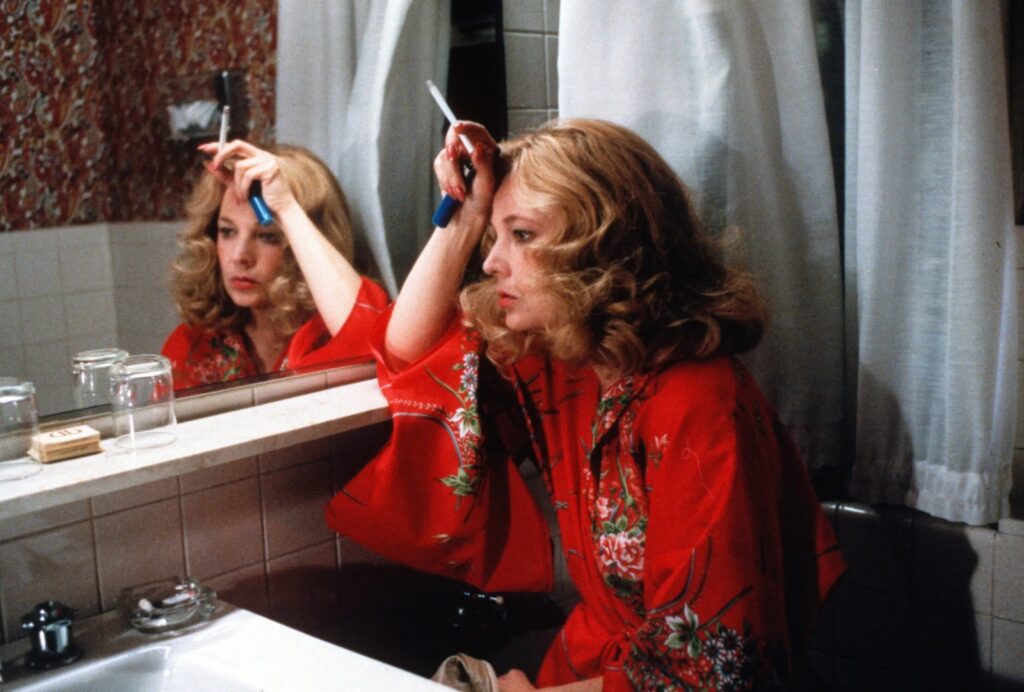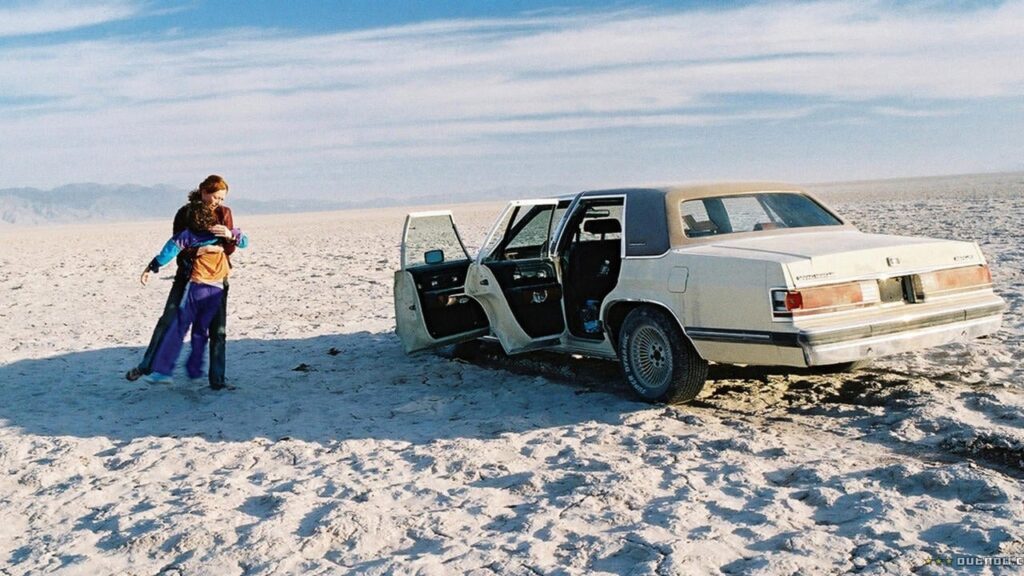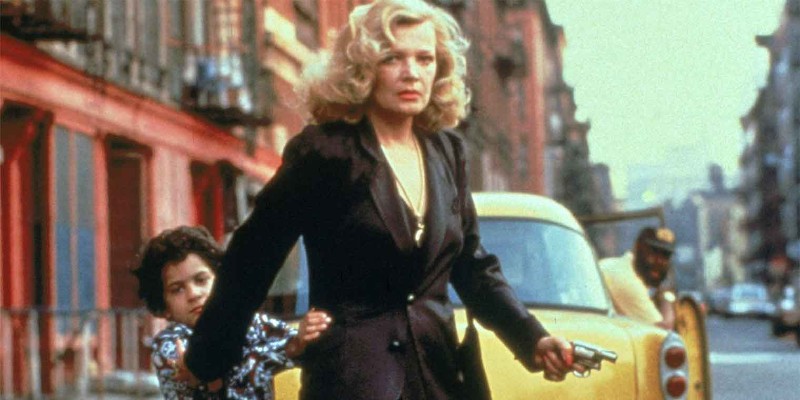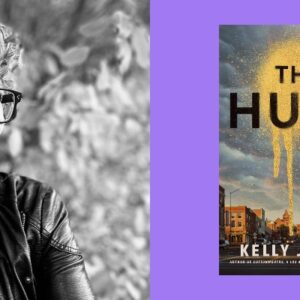Two films that work as a double feature are John Cassavetes’ Gloria, from 1980, starring Gena Rowlands, and Erick Zonca’s 2008 film Julia, with Tilda Swinton. Gloria, it’s no secret, inspired Julia; both movies focus on a forty-some-odd woman, unattached in life, who through a violent chain of events comes to have a young child in her custody. Neither woman appears to have the slightest trace of what is called “maternal instinct”, and both Gloria and Julia wind up being on the run from forces, male-dominated, trying to harm them. And yet, in their overall approach and how they unfold, the two films are quite different. They function more as diametric compliments to each other than anything else. It’s as if Zonca, admiring Gloria, took much of what drives Cassavetes’ film and turned the material inside out for his own film.
Gloria, I think, is the more deceptive film of the two. Whenever I watch it, I’m struck by its oddness. I’ve always found this oddness difficult to pinpoint, though. Is it the movie’s tone? Not exactly. Does it go off on surreal or enigmatic tangents? It doesn’t. The relationship between Rowlands’ Gloria and John Adames’ Phil, the idiosyncratic banter between the grown woman and the young child, contributes to the strangeness, but something else does as well. It’s taken several viewings, over many years, for me to grasp what lies at the root of the film’s peculiarity, and what it comes down to is how Gloria has a seamless mix of naturalism and fantasy. The naturalism is there in plain sight from the opening sequence, in the nighttime overhead shots of New York City that segue into daytime shots of the area in the Bronx around Yankee Stadium. We see a municipal bus moving along, three guys hanging onto its back fender and then jumping off, perhaps to go the baseball game in progress, and finally a woman (Julie Carmen) on that crowded bus with a cart full of groceries. A sudden stop by the bus makes her fall over, and though people are civil and help her to her feet, by the time she gets off the bus, struggling with her cart, kicking it down the bus exit steps to reach the street, we have the unequivocal feeling that we’re in the real world where a quotidian task like returning home with food is a battle. It’s all very New York, urban. Just leaving your house means, through no fault of your own, and without even encountering crime, that you could be in for a rough day. But while Gloria’s verisimilitude is apparent from the get-go, its fantastical qualities are not. They only reveal themselves as the movie progresses, and they do so subtly, in a deadpan fashion.

Gloria is usually described as a gritty crime film or a neo-noir thriller, or something similar, and these labels are not inaccurate. Gloria Swenson (that name!), a mobster’s ex-girlfriend, takes a little boy under her care as they go on the run from gangsters. The boy has an incriminating book that his mob accountant father, killed by the gangsters for informing on them to the FBI, gave him. With his mother and sister executed also, the boy has no family left, no one but Gloria, who took him from his parents grudgingly, to protect him. The chase is on, and it’s the way Cassavetes shoots everything and the locations he uses that makes Gloria feel realistic. It has a vérité look, with naturalistic lighting, and the story hurtles along from the streets and dingy apartments of the South Bronx to midtown Manhattan to a Queens flophouse to a motel in New Jersey to a decidedly unglamorous gangster’s lair. Gloria and Phil spend a lot of time moving around by New York City buses and subways crowded with people. There are shoot-outs and showdowns out in the open and in confined public spaces, Gloria and Phil against the pursuing mobsters. The plot is tight, and in its general structure, not unfamiliar. Cassavetes wrote the script thinking he wouldn’t direct the film, and he once called Gloria little more than a “thoughtless piece about gangsters”. He said he “was bored because I knew the answer to that picture the minute we began. And that’s why I could never be wildly enthusiastic about the picture – because it’s so simple”.
True, Gloria does not have the emotional complexity of Husbands or A Woman Under the Influence or Opening Night. Cassavetes is a filmmaker who, in the sense John Keats meant, has negative capability. He’s “a man capable of being in uncertainties, mysteries, doubts, without any irritable reaching after fact and reason”. To watch a typical Cassavetes film is to be immersed. You’re made to live on the closest terms with his characters and you discover things the moment they do. Cassavetes explores, not knowing the answers, and you explore with him, and like his characters, you do not get definitive closure, a cathartic release, after the intense crosscurrents you’ve been put through. He doesn’t spoonfeed you statements of fact or assertions of reason. Gloria, by contrast, is simple, or simpler, but Cassavetes’ playfulness, his assiduous screwing around with gangster film expectations, contradicts any notion that the film is merely “thoughtless”.
To begin with, it’s amazing how everything always goes right for Gloria. This one woman with her purse and handgun repels and intimidates whoever comes at her. She does have a ferocious attitude, but she has no particular combat skills; Gloria is not a kick-ass heroine in the mode, say, of Charlize Theron in Atomic Blonde. Regardless, the Cassavetes style seems realistic, so though you do chuckle from time to time, wowed by Gloria, amused by her toughness, you don’t really question the fantastic quality of what you’re seeing. Could this partly be, at least for those who know Cassavetes’ films, because you come to his work expecting realism? There’s a presupposition one has watching a Cassavetes movie, but as filmmaker Anna Biller points out in a piece she wrote about the film, “[Gloria] falls more into the tradition of a literary romance in which a hero slays dragons, than it does of a work within the traditions of realism.” It is, as Cassavetes himself put it, “an adult fairy tale”. But it’s a fairy tale with contradictory elements, blending its vérité style (and boy, does it beautifully capture New York City of the late 1970s) with a story, to quote Biller a final time, that takes place outside the “causes and effects in the real world”.
On the street, Gloria resists gangsters talking to her from a car, demanding she hand over Phil, then shoots at them with her handgun; they drive away scared and without even trying to shoot back. At a Penn Station restaurant, holding her one same handgun, she faces down and disarms six thugs sitting at a table. They freeze underneath her withering glare, then retreat from the restaurant, which allows Gloria and Phil to escape the restaurant by a back entrance. On a packed subway, with a little help from bystanders, she escapes the two guys after her and has the temerity to mock them to boot. And so it proceeds, Gloria able over and over to outfox, get the jump on, intimidate the numerous professional criminals after her. She doesn’t appear to have any extra ammo with her, but never runs out of bullets, and her very presence, it seems, makes her pursuers slow on the draw and bad with their aim when they shoot.
Two other key scenes can perhaps be put down to something magical, a force that allows the mighty protector and her charge to remain together no matter what the odds. In the subway sequence, Gloria exits the train at a stop, but Phil can’t make it onto the platform because the crush of people entering the train car keeps him in it. When Gloria, through the departing subway’s window, tells him to meet her at 42nd Street, he clearly says “What?” a few times and “I don’t understand”. Yet there he is at the 42nd Street station soon after, waiting for her and waving, when her train pulls in. Did he ask someone on the train he was on for clarity about 42nd Street? It’s possible, but the inexplicable nature of their brief separation and then reunion is repeated at the film’s climax.
Before going off to New York from New Jersey to meet the gangsters for a last time, Gloria tells Phil that if she does not return to the hotel where they’re hiding, she’ll meet him at the train station in Pittsburgh. Nothing more. She doesn’t provide a specific spot for him to find at the train station. For rendezvous directions, that’s vague enough, and when Phil arrives at the station later, there is no sign of Gloria. Phil looks a bit lost. A conversation with a friendly man leads to Phil saying out of nowhere that he’s supposed to meet someone at a cemetery, and when he says he forgot what the cemetery is called, the man gives him the name of one. Phil, who has money on him, takes a cab there. In this roundabout and somewhat baffling fashion does Phil end up in the graveyard for the film’s last scene, where Gloria and Phil reunite. There’s a slow-motion hug and surging Bill Conti music. But how the hell did Gloria know that Phil went to that cemetery, or any cemetery? They do visit a New York cemetery early in the film, but still. Now they’re in Pennsylvania, one presumes. And she told Phil to meet her at the Pittsburgh train station.
None of this final section has any logic to it, and I’m not describing it to nitpick. One can’t imagine that Cassavetes did this because he wasn’t paying attention or didn’t care. The blatant lack of causality here is evidence again that Cassavetes, the film’s realistic surface notwithstanding, is calling upon narrative tropes in Gloria that have nothing to do with realism. He just disguises that aspect well.
***
When he made Julia, French filmmaker Erick Zonca was best known for his 1998 drama The Dreamlife of Angels (La Vie rêvée des anges), a raw and involving movie about the relationship between two young working-class women in a small French town. Julia, his first film in English, was his third feature, and he shot it on location in southern California and Mexico.

Whereas in Gloria we meet a woman stable and centered from the start, someone we know from the instant we see her has her shit together, Julia is introduced as a person with a major drinking problem, who spends many a night partying at bars and then waking up in the morning with a guy she picked up, maybe in a bed, maybe in the guy’s car. In short order, because of repeated lateness and erratic workplace behavior, she gets fired from her job. She attends AA meetings half-heartedly. With no income and a life going in toxic circles, she has put herself in the desperate position of the classic noir protagonist. Unlike Gloria, she has no ties to the underworld, no criminal background whatsoever, but when an opportunity to get rich through an illegal act presents itself, she does not let her utter inexperience in the area she’s getting into stop her.
Nothing in Julia smacks of a fairy tale. It unwinds like a true crime story, with a nerve-jangling unpredictability, Julia the amateur criminal winging it at every step. Almost nothing she does goes as she planned. She’s motivated by self-interest, and crucially, in a total reversal of the Gloria set-up, she’s no protector of a child, but a woman who kidnaps an 8-year-old boy. That it’s at the behest of the boy’s mother, a fellow AA attendee, doesn’t make the act sympathetic. It’s true that the mother, a Mexican woman named Elena, may have had Tom taken from her by the boy’s wealthy American grandfather – on this level we understand Elena’s anguish – but Julia’s agreement to abduct the kid has nothing to do with righting a wrong or helping an underdog. After initial reservations about the scheme, she acquires a gun and does the dirty work, snatching the boy from a location she and the mother scouted, and it’s clear that for Julia this is about one thing, the ransom money. The boy, for quite a long stretch of the movie, is a pawn to her, not much else.
With Gloria, Gena Rowlands played a role that went against assumptions. She’s fascinating but not complicated, certainly not to the extent she’s complicated in other Cassavetes films, and to see her play a person so tough, having fun as she is with the ex-moll character, was something new at that point in her career. She’s full-blown hardboiled, but she makes sure to emit some warmth, often through the wisecracks and half-serious put downs she aims at Phil. It’s the contrary with Tilda Swinton, who does not solicit audience sympathy or attempt likability. She’s an actress who revels in creating audience unease, and in this film, though more uncorked than she usually is onscreen, she keeps you at a distance emotionally, which is perfect for noir. Whatever the underlying merit of the plot of Tom’s mother to get him back from the boy’s grandfather, one can’t but feel uncomfortable seeing Julia, in a black fright mask (which the mother told her not to use, saying it looks like “Death”), pointing a handgun at the terrified boy, screaming at him, forcing him into the car’s trunk. The film takes sizable risks here, challenging you to keep following Julia without being repelled by her. Can the boy’s rich grandfather be such a jerk that it’s better for Tom to go through this trauma than for Julia to be caught so the boy can return to his normal life? In the motel room where Julia takes Tom, we have a long sequence of a scared boy with his fidgety abductor, and it’s all, on first viewing especially, alarming. Julia ties Tom up, gags him with duct tape, puts him on the floor behind a couch to hide him while he sleeps. But if you watch Julia again, this sequence, while never not disturbing, reveals its extremely dark humor. In her mask, wielding her gun, Julia orders Tom to shower and dry himself, to get into bed and close his eyes, to take the medicine (sleeping pills) she got him, and to eat the atrocious junk food she bought him. When she finally buys him clothes so he can change out of his bathing suit, they don’t fit him properly and he makes no secret of disliking the sneakers. Cigarette in her mouth, pouring herself a drink, Julia is the picture of exasperation. “Why can’t this kid do what I tell him?” she seems to be thinking. If you take kidnapping out of the equation, is she behaving all that differently than any other mother who has tried to get her kid to do the most basic things? Exhausted, she passes out on the sofa, not precisely an exemplar for maternal behavior or for how to be a vigilant hostage holder.
These lapses in attention will cost her later. After the remarkable chase scene that ends with her crashing through the wall that lands her in Mexico, her abandon and continued drinking put Tom in worse peril than he was in with her. It’s unfathomable to think that Cassavetes’ Gloria would fall into this predicament. All the while, as in the earlier film, the lighting in Julia is natural and the shooting on location. The roving camera seems to be catching human fear and greed and scheming on the fly. Though you felt Gloria had to end well, however it would reach its happy conclusion, in Julia you have no sense of where the story’s heading or how it might finish. You don’t have the confidence in Julia that you do in Gloria. The criminals Julia encounters in Mexico are not the slow, easily intimidated, mainly older men Gloria went up against, and it’s evident that Julia is in way over her head. She scrambles, cajoles, and improvises, and Zonca has you on tenterhooks thinking this entire misadventure, set in motion by an alcoholic who’s also an inveterate liar, may end in catastrophe.
The film doesn’t quite end in disaster because Julia does something at the last minute in which she foregoes self-interest. She won’t get clear of the mess she’s in unless she gives up the money she’s been after the whole movie. There’s a touch of redemption for her, but not much. We last see Phil in Gloria’s arms with a joyful look on his face. In his immediate future, he’ll be with her, his new family, safe. Julia has Tom in her arms at the finale, but the close-up on the child’s face shows fear and trembling. Not because he’s with Julia, who he knows won’t hurt him, but as a reaction to all he’s endured. If you wondered before, you don’t now: there’s no chance this kid will not be psychologically scarred for a long time, and because of Julia. She’s the one who upended his life. And she doesn’t intend to keep him; there’s relief in her voice when she declares “Okay. I’m taking you to your mother.” That’s a mother, mind you, who is hidden somewhere and a recovering alcoholic herself, and perhaps somewhat crazy. It’s hardly the fairy tale, Hollywood ending Cassavetes gives us, but it’s the appropriate wrap-up to a film that has taken us on an uncompromising and brilliantly unsettling ride.
What would John Cassavetes have thought of Julia? Did Gena Rowlands ever see it? Considering his lukewarm assessment of his own film, I think Cassavetes may have been surprised that Gloria would become a film as appreciated as it is, let alone a film other filmmakers would draw upon as an influence. But an influence Gloria is, and Julia is a prime example of how one film can be inspired by another and even follow a comparable plotline and yet deliver a completely different viewing experience than the film that inspired it.

















